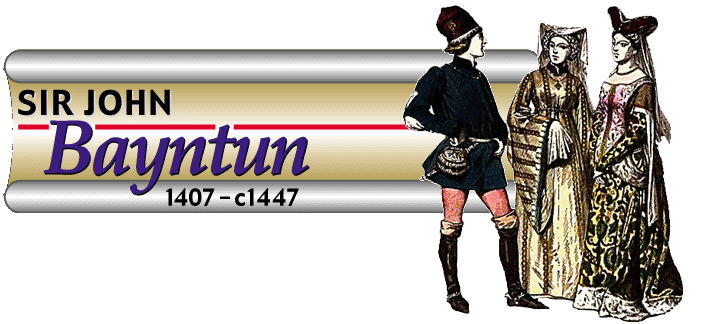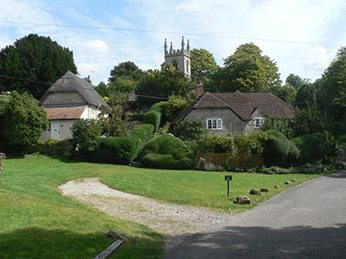
|
Timeline
1407: James I of Scotland held captive in London for 18 years. 1408: As Winter set in, Henry IV became very ill. 1413: Henry IV, who had been on the throne for 14 years, died at the age of 46 in the Jerusalem Chamber, The Chapter House of Westminster Abbey, while on a visit there on 20th March. He was laid to rest in Canterbury Cathedral – the only English monarch to be buried there. He was succeeded by his 25 year old son, Henry V (Plantagenet, House of Lancaster), who was crowned King of England on 9th April at Westminster Abbey, Middlesex. 1415: England, led by Henry V, defeated the French forces at the Battle of Agincourt and captured Harfleur. Later Henry captured Normandy and advanced as far as Paris. 1420: Northern France in English hands. 1422: Henry V died from dysentery on the Bois de Vincenne on 31st August at the age of 33. He had been on the throne for nine years and was later buried in Westminster Abbey, Middlesex. His only heir was his 9 month old son, Henry VI, who in name was both King of England and of France, as his grandfather, King Charles VI of France, died two months earlier. |
John Bayntun was born in December 1407 at Faulston House, in the County of Wiltshire. He was most likely known as John de Benton or Baynton, however we see the spelling of the surname changing to Bayntun around the beginning of the 17th century. He married his first cousin, once removed, Joan Dudley, who was the daughter of Sir Richard Dudley and his wife Elizabeth de Beauchamp and the granddaughter of Sir John de la Roche and his wife Wilhelma de la Mare. An Inquisition Post Mortem into John's father Nicholas Bayntun's estates in Sussex, Hampshire and Wiltshire shortly before he died, on the 15th January 1422, in the ninth year of King Henry V (1421/2) and that same Inquisition named his next heir as his eldest son John Bayntun, 16 years of age on the day of March next after the Feast of the Holy Trinity last past. The Hampshire Inquest was held at Barton Sacy on a day in March next after the Feast of Holy Trinity (young John Bayntun's birthday) 1422 and dealt with the Manors of Daundeleswyke and Chilton Candover, both held of the Bishop of Winchester, by unknown service. The date of Nicholas' death and the heirship clause were as in the Sussex Inquest. The Wiltshire Inquest held at Ambresbury on a Thursday a week after Pentecost, 10 Henry V, covered the Manor of Faulston which Nicholas had held jointly with his wife Joan, the Manor of Nether Wroughton, four messuages in New Sarum and the Manor of Compton Chamberlayn. After Nicholas' death the feoffees in trust of Compton Chamberlayn had released the Manor to the widow Joan and she had entered without license from the King for which offense a fine of £10 was levied. The King had granted the Manor to Joan, Nicholas' widow, with successive remainders to John Bayntun, Nicholas' son and heir, and the heirs of his body, then to Agnes, Alice, Eleanor and Isabel Bayntun, the daughers of Nicholas and Joan and their heirs and finally to the right of Nicholas. They did this and Joan entered the Manor without the Royal Licence but on the 19th February 1422, the King, for a fine of £10, pardoned them. When Sir John de la Roche, died on the 30th September 1400, his property was divided between his co-heiresses (his daughters), but some of these manors were held in dower by his widow until her death on the 31st October 1410. In her will, executed in 1411, a great deal of de la Roche and de la Mare property was conveyed to her grandson, John Bayntun who was just 4 years old. Wilhelma was the heiress of her father, Robert de la Mare, and a lot of this land was also settled on her grandson. It appears that Robert, the son of Sir John and Lady de la Roche, died before his mother. An Inquest Post Mortem was held on the estate of Sir John Roche on the 27th October, 2 Henry IV (1400) but the document is so defaced and illegible as to be useless. Because John was just 4 years old at the time, an agreement was drawn up, with Wilhelma giving control of the manors to her eldest daughter, Elizabeth and her husband Sir Walter de Beauchamp, until such time as John Bayntun became of age. The following
is the wording of this Indenture, dated 1411: Wilhelma de la Mare's last Will and Testament, dated 1410, no month or day named and was proved on the 5th November 1410. She wished to be buried in the parish church of Bromham beside her husband John Roche, Knight. She named her son-in-law, Sir Walter de Beauchamp, as overseer of the administration of her estate, probate being allowed in the Prerogative Court of Canterbury on the 21st November 1410. Sir Walter was married to Elizabeth de la Roche, the sister of John's mother, Joan de la Roche and he and his wife were therefore entrusted with the wardship of lands specifically bequeathed to Wilhelma's grandson, John, for which custody he undertook to pay annually into the Royal Escheator the sum of 80 Marks until John Bayntun reached the age of 21. But by December 1428 John Bayntun had become of age and was in possession of the following manors: THE
MANOR OF LAVINGTON THE
MANOR OF CHERINGTON THE
MANOR OF SHAW THE
MANOR OF LOWER HEYFORD THE
MANOR OF TOLLARD LUCY THE MANOR OF HAUN THE
MANOR OF MARSH BALDON THE
MANOR OF DELAMERES OR LAMBERDES NEBELS
ESTATE AND FARM THE
MANOR OF PRESTON THE
MANOR OF TARRANT GUNDEVILLE THE
MANOR OF FAULSTON Sir John Bayntun was Sheriff of Wiltshire in 1429-30 and again in 1443-44. He was knighted in 1434 and until his death, was a member of a long series of offices in the county, as well as being a Member of Parliament for Wiltshire County in 1445 and 1446. The office of High Sheriff is of great antiquity, dating back to Saxon times. It is the oldest secular office in England and Wales, after the Crown. It is not clear in what year Sir John Bayntun died but a collection of deeds transcribed in the 17th century, show him living at Faulston on the 14th July, 25 Henry VI (1447) as a Distributor of an Allowance on a Tax in Wiltshire. There is no record of the burial place of Sir John, but it is thought he and his family before him, may have been buried in a square field, known as Chapel Close, which might have been either the site of a Chapel or a field attached to the Chapel which was next to Faulston House. There are no visible signs of any graves today, unless buried beneath the ground. When Sir John Bayntun died he was succeeded by his son and heir Sir John Bayntun |



